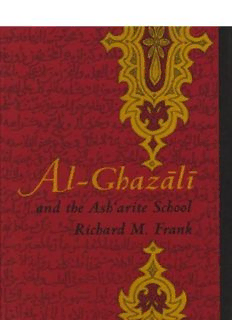
Al-Ghazālī and the Ashʽarite School PDF
Preview Al-Ghazālī and the Ashʽarite School
AI-GJraziiliaNd the Ash~arite School DukeMonogrllphs in MedintUIImlRenllissllnceStudies:cS Editorial Committee: Caroline Bruze1ius,ArthurB. Ferguson, JoanM. Ferrante, EdwardP. Mahoney(Chairman),DavidC. Steinmetz, BroceW.Wardropper,Ronald G.Witt AI-Ghaziilrand the Ash1arite School R.M. FraHk Duke Unil1ersityPress DurhamandlAndon 1994 © 1994DukeUniversityPress Allrightsreserved PrintedontheUnitedStatesofAmerica onadd-freepaper 00 DesignedbyCherieH.Westmordand TypesetinGalliardwithTrajanusdisplay byTsengInformationSystems,Inc. LibraryofCongressCataloging-in-PublicationData onthelastprintedpageofthisbook IH Memoryof Carol Putnam (d.April16, 1993) aHd of Tom Prufer (d. March23, 1993) COHteHts Preface ix INtroductioN TheProblem KalamintheTraditionalView S 0" 2. AI-Ghwlf the PltUeofKillamAHfONgst the ReligiousScieNces 7 KalamAccordingtotheTraditional Classification 7 EssentialNatures, Logic,andtheLawfulnessof SecondaryCauses 15 KalamintheClassificationoftheReligious Sciencesin1!?yR''u1ibnai-dIn 22 3. Two "Ash'arite"TrtUts: al-Iqti~ad fi 1-I'tiqadandal-Qudisivvah 2ll Al-Iqtifad 28 MoralObligation,AgainsttheMu'tazila 32 CreationandSecondaryCauses 36 ExegesisofPropheticTextsConcerningthe CosmicSystem 39 \/jjj CONteNts TheHumanPowerofVoluntaryActions 42 God'sEssentialAttributes 4-7 CreatedBeings,MaterialandImmaterial 4-8 TheRationalEvidenceofProphecy 67 Al-Qudsiyyah 68 Summary 71 4. OpeN CONflictwith theAslc'anteSchoo' 76 Fay~aJaJ-tafiiqahandaJ-MunqidhminaJ-rjalaJ 76 [ljamaJ-<mviimm'an<ilmal-JurUim 80 5. COHt'USiOHS 86 TheRhetoricofHarmonization 86 Al-GhazalI'sRelationtotheAsh'ariteSchoolasReflectedinthe ChronologicalSequenceofHisWritings 91 Notes 103 References 137 IndexofProperNames '+3 IndexofSubjects 145 IndexofArabicWords 1+9 Preface Thepresentstudy,thoughfromonestandpointlongin preparation, camenonetheless forth quite unlooked for. I had long feltthatalthoughtherehadbeen,andcontinuedtobe,muchlearned talkconcerning al-GhazalI's adaptation and adoption ofelements of Aristotelian philosophy~thelogicinparticulac~in suchawayasto updateand in modestmeasure torectifY someofthe earlierlogical, conceptual, andtheoreticalshoncomings oftraditionalMuslimthe ology, there had been all toolittlethorough andsystematicstudyof thetextswithregardtothemostsignificantissuesinvolved. Sugges tions and assertions concerningthe matterwere madewith greater assurancethanseemedwarrantedbythefoundations onwhichthey rested. The primary focus ofmy own work was, however, concen trated in classical kalam; al-Ghazali was therefore ofonly marginal interest and I had little inclination to take up the question oftheir relationship.That the relarionofhis theology to thatoftraditional Ashcarismwasatleastambiguous andrequiredserious investigation was, however, broughtacutelytomyattentionwhen, inpreparinga rather general lectureon predestination in Islam for a nearbycom munity college in the spring of1985, I reread Book XXXV ofIhyti' cuJumai-dinfor thefirst timeinmanyyears. Ashorttime laterthen, on readingaJ-Maq~adaI-llSnaforthefirsttime, it becamealtogether cleartomethathisformalconunitment toAsh<aritcorthodoxywas tenuousintheextreme.AccordinglyJortheParis·Penn-Dumbarton Oaks Colloquiumoninheritance and borrowing in the middle ages (Heritage et emprunts eu1turels au Moyen Age) hdd in Morigny in the fail of1986) I prepared a paper entitled "AI-GhazaIrs use of Avicenna's Philosophy" as akindofpreliminary studyofone major aspectofthe question.Thatwasabeginning. Subsequendy,in1988, inthecourseofpreparingapaperentidedC<al-GhazalionTaqlid,"my attention wasdrawn to further aspectsofthe problemofthe status andlocationofal-Ghazali'stheologyrelativetotraditionalAshearism and I decided that the somewhat tentative studydone in twoyears earlier, the likelihood ofwhose eventual appearance seemed ever moreremotc,l hadto bemorefullyelaborated.Withthepublication ofCreation lind the Cosmic System in1992, my interest in al-Ghazali waswaningrapidly.Theapparentinconsistencyofthethingshesays explicitlyconcerningkalamcontinued,however, totroubleme and, not having examined the data ofthe texts with this question spe cifically inmind, I fancied thatbymakingafew appropriatedistinc tions the mattercould belaidquietlytorestonthe basisofmaterial alreadyassembled.Alas,thingsareseldomsosimpleastheyappearat adistance.Al-GhazaJrsexplicitstatementsconcerningkalamandhis allusions to the Ash<arite school proved inevitablyto be imbedded in contexts that precluded a simple analysis within the formally re strictedframeworkoriginallyprojected.Thoughtheaimofthestudy remainedessentially the same, the questions to be addressed multi plied and theweb oftheir interrelationships became more difficult tomapastheyspreadmorewidelythroughthefabric ofal-Ghazili's works.Beneaththesurfaceofanoriginallyrathersimplequestionlay somethingmoreserious, andmoreinteresting. Al-Ghazalishowshimselfinhiswritingtobe averycomplexand problematic personality, intellectually pompous, yet beset by inner uncertaintiesandoftenconspicuouslysuperficialinhis treatment of important questions. Unable to achieve complete confidence in the truth of his speculative theories, he turned to sufi asceticism and
Description: